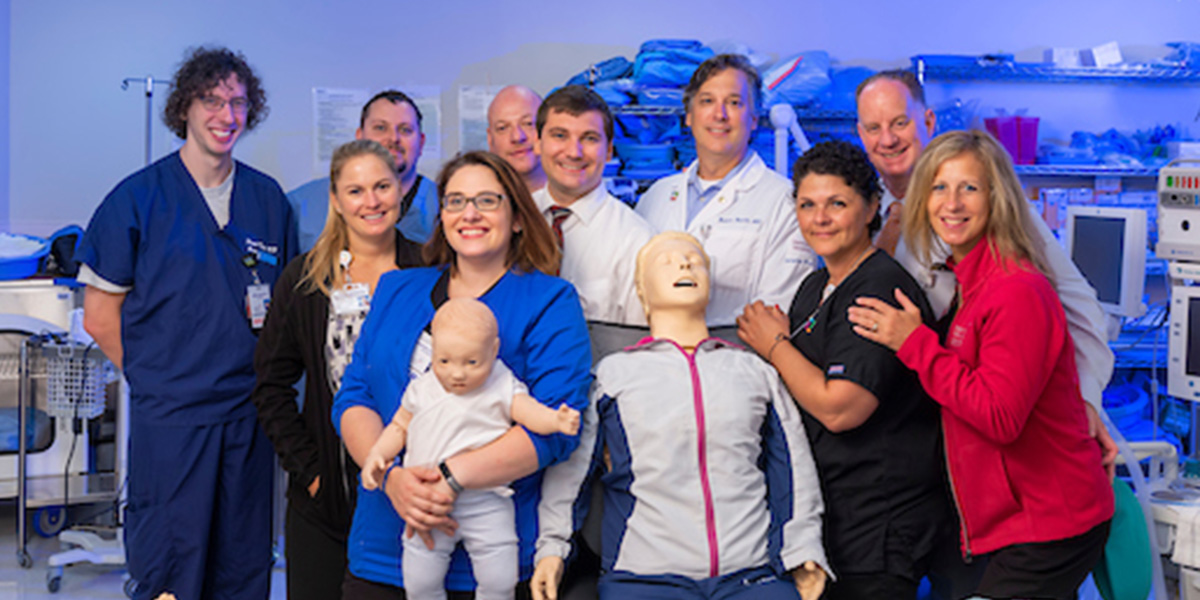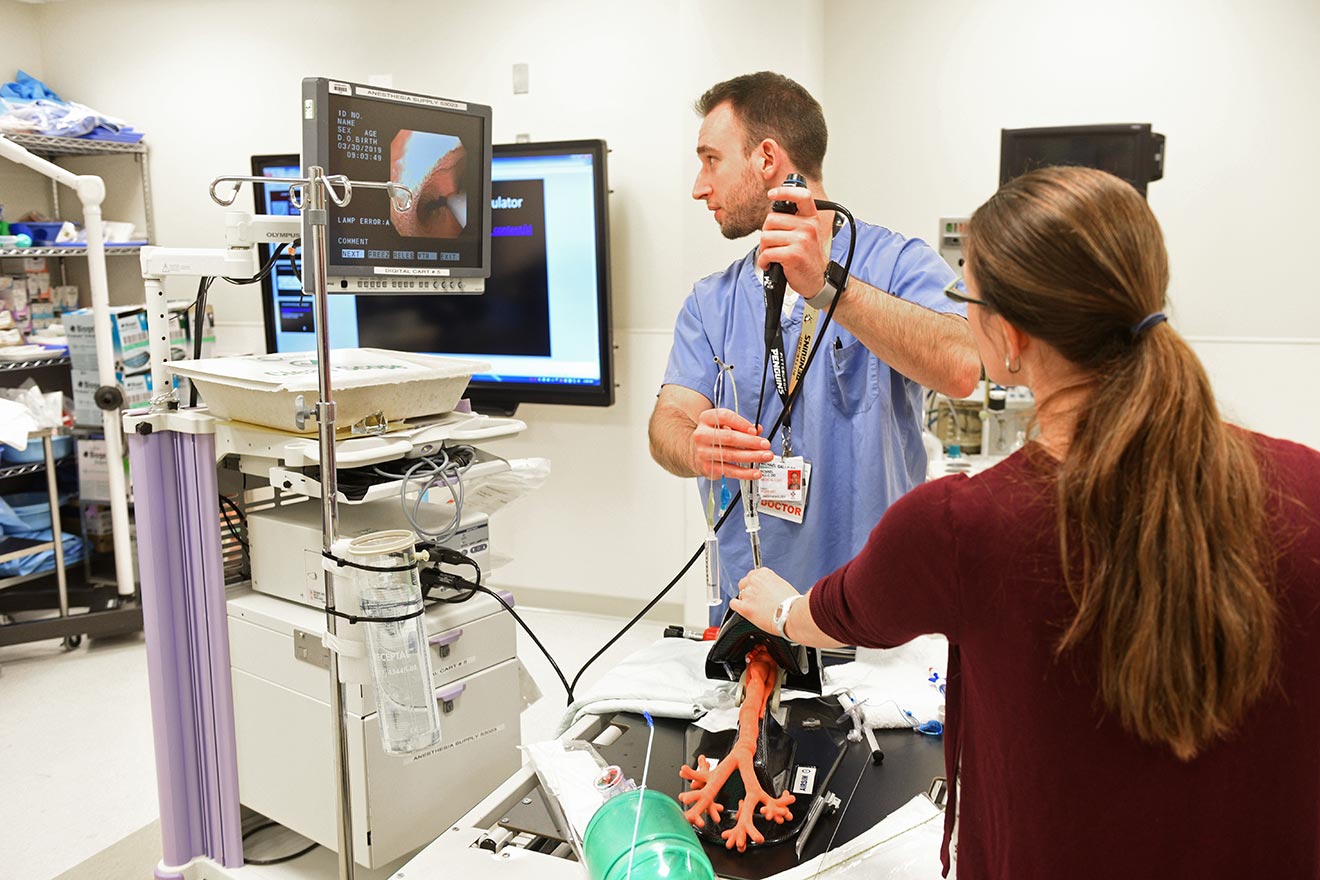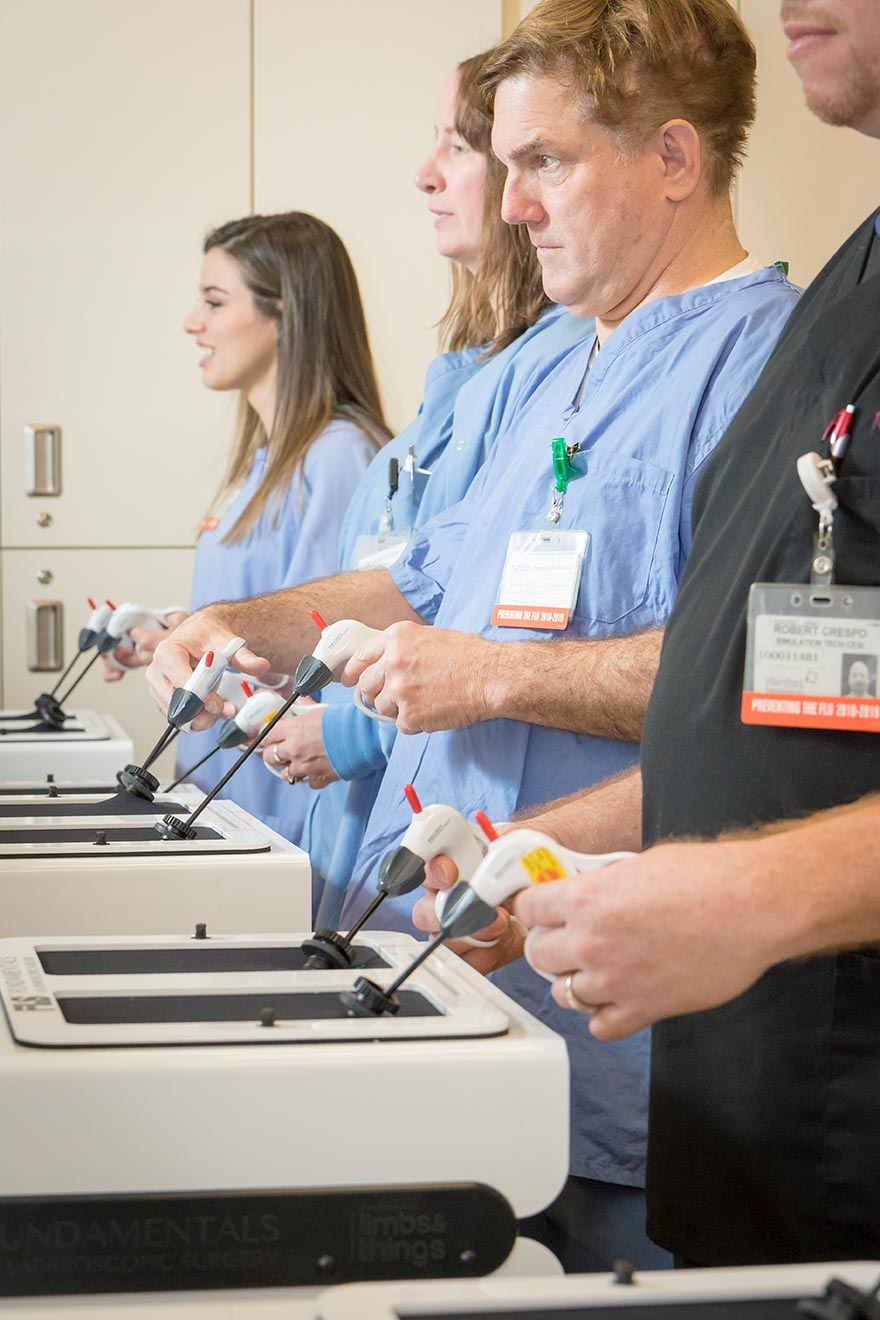CESI: Inside the Center for Education, Simulation and Innovation
Practice makes perfect
By Bryan Sundie
Photos by Chris Rakoczy
It was around noon when a patient named Chris was found unresponsive in his room, seemingly in cardiac arrest. No pulse.
Without hesitating, a diminutive nurse sprang into action, driving her knee into the mattress as she forced her interlocked hands down on his breastplate to start chest compressions. A defibrillator came alive with beeps and a robotic voice, and someone delivered a shock as a doctor rushed into the room, asking, “What’s happened, what’s been done?”
A disembodied voice called, “She needs to get deeper,” and the nurse stood on a stool to improve her angle.
A different nurse pushed medicine ordered by the physician. Another shock. After eight minutes, a pulse was detected. They maintained chest compressions to preserve the patient’s weak heart rhythm, and nurse educator Deborah Russo flashed a wide grin. “How do you feel?” she asked the team. The answer was familiar. “Honestly, that’s pretty realistic for a sim lab.”
The “sim lab” where the scene unfolded was Hartford HealthCare’s Center for Education, Simulation and Innovation (CESI), Connecticut’s first and largest simulation center with 45,000 square feet of training space and enough interactive technology for a sci-fi flick.
“Watching or participating in training, immersing yourself in the experience, is the best way to understand the value of this center.”
CESI training ranges from seemingly simple — using equipment to transport patients or reading a cardiac monitor — to sophisticated robot-assisted surgery and emergency care for police dogs.
“Watching or participating in training, immersing yourself in the experience, is the best way to understand the value of this center,” said Rebecca Gleason, a respiratory therapist and CESI educator. “You really have to be here and be a part of the action.”
The “sim lab” where the scene unfolded was Hartford HealthCare’s Center for Education, Simulation and Innovation (CESI), Connecticut’s first and largest simulation center with 45,000 square feet of training space and enough interactive technology for a sci-fi flick.
CESI training ranges from seemingly simple — using equipment to transport patients or reading a cardiac monitor — to sophisticated robot-assisted surgery and emergency care for police dogs.
“Watching or participating in training, immersing yourself in the experience, is the best way to understand the value of this center,” said Rebecca Gleason, a respiratory therapist and CESI educator. “You really have to be here and be a part of the action.”

CESI Staff
Back row (left to right) Dan Testa, MD; Geoffrey Gelinas;Robert Crespo.
Middle row (left to right) Heather Muirhead; Chris Madison; Thomas Nowicki, MD; Steve Donahue. Front row (left to right) Debora Russo; Josephine Faienza and Becky Gleason
Training Drill
Innovation
The action frequently includes simulation of what Gleason called “high-risk, low-frequency,” life or death stuff like stroke or heart attack. Simulations happen in fastidiously designed spaces mimicking hospital settings, from operating rooms to maternity suites. Crash carts, tubes, tools, wiring, medicine — if it’s in a hospital, it’s in the CESI training room. The patients are mannequins, healthcare’s version of flight simulators. With the click of a mouse, they sweat and blink their eyes, urinate and bleed. Seizures? They have them. Give birth? You bet. They have pulses, and their limbs can be amputated if that’s required. Mannequins will do just about anything a real patient might, controlled by “operators” such as Russo or Gleason.
The operator job is a blend of clinician, teacher and maestro, done from closet-sized control centers behind double-sided mirrors.
Cameras provide several angled views while operators receive real-time performance feedback from software logging whether participants hit specific targets. Chest compressions deep enough? Medicine administered?Operators speak into microphones and answer questions from trainees who wash their hands upon entry and treat mannequins as if they’re human.
“It’s been learning as you go — the functionality of the mannequins, practicing the software,” Gleason said of her journey as an educator. “It’s hard in the beginning to teach and operate at the same time — watch students from behind the glass, see what they’re doing, focus on changing the software to adjust the blood pressure if they give the wrong medication. It takes a lot of practice.”
Life-Long Learning
From left to right: An emergency medical services worker trains on mannequins in a simulated maternity/birth scenario; The ‘perpetrator’ is taken into police custody during a mass casualty/active shooter drill; At an Advanced Airway Conference and hands-on workshop earlier this year,Michael Gallo, MD of Connecticut Children’s Medical Center, center, works on the lung isolation technique at CESI; Simulators help train specialists on the surgical robot.
Trainees are debriefed afterward. Microphones dangling from ceilings capture discussion. There’s artistry in sessions, Gleason said, and she credited Medical Director Thomas Nowicki, MD, for refining the approach with self-analysis.
Hartford Hospital neurology nurse Nate Dorian said he likes to practice as much as possible because emergencies happen very infrequently in real life. When they do, you want to be ready. Dorian recently trained on stroke care.
“You don’t want to be fumbling around when you have a patient dying,” he said.
CESI has 33 employees, a diverse staff that Director of Operations Stephen Donahue said reflects a desire to offer training in many disciplines.Last year, more than 20,000 people participated in CESI programs supported by physicians, nurses, paramedics, military and emergency medical and simulation technicians. A mobile unit hosts off-premises trainings. Most participants are healthcare providers, but CESI attracts interest from corporations, law enforcement and the military.
Looking at the modern workspaces and labs in CESI today, it’s hard to envision humble beginnings that once had markings of a start-up. Years of discretionary collaboration of people excited by the possibilities of innovative cognitive educational curriculum and technology proved vital. Getting it under one umbrella wasn’t easy.
“A lot of this has been done with sweat equity,” said Steven Shichman, MD, CESI’s executive director, who held keen interest in the power of technology in surgery. Roughly two decades into the CESI voyage, old pros like Drs. Shichman, Donahue and Nowicki are as passionate as ever, and appreciative of a committed staff.

Cesi’s Chris Madison
“I always like pushing the envelope,” said Chris Madison, a simulation tech developer and mix of computer programmer, engineer and a really high-end handy man. He keeps mannequins in shape, making repairs and modifications, and works on software to automate training sessions.
Such innovation personifies healthcare’s evolving nature. “Each and every day, we’re just getting started,” Donahue said.
After “saving” Chris the mannequin, nurses examined their performance. Somebody forgot to mark a syringe after drawing medicine, and Russo delivered compression statistics. Some too fast, others too slow. Russo seized the moment, reminding them of why they were there.
“It’s really just a learning experience so you know where to improve,” she said.
See more by going to the CESI website at hartfordhealthcare.org/cesi or checking out videos at HartfordHealthCare.org/CESIvideos




